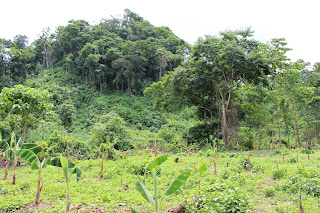The House beyond the Talahib Grass
The path that I had taken through the tall talahib grass (Saccharum spontaneum) was as visible as any trail in a fresh snowfall. We are running against time. The July post-summer midday sun is upon us. The sweet scent of the talahib grass refreshes the air but my body sweat says different. The fifteen-minute walk wasn't exactly arduous. I am entertained by Kuya Paulo Cauayan and immediately set the interview as we glide through the dancing grasses. It was a theatrical scene laid out in an expansive stage. The burst of shades of green gradually transitions from the plains jugged up to the mountains around us.
 |
| Kabalatanaw stream. |
The nearly-jewel blue stream of Kabalatanaw reminds us that we're near our destination yet the promised house is nowhere to be found. Still grasses. "A few more streams, perhaps? or five more mountain ranges?", I mentally whispered as I ask Kuya Paulo more questions. The concept of walking distance to the Mangyan Iraya must be far-fetched from what I originally pictured.
 |
| The small house beyond the talahib grass. |
Isolatedly erected from the rest of the sitio sits a familiar house I have seen a hundred times in my elementary textbook. The front yard wasn't exactly a yard. It was a 360 degree-view of mountains, fruit trees, the herbaceous banana plants, and the newly-sprung rice plant. It was a complete summary of rural living. The backdrop was luxurious that came in the form of rolling sloping hills. A small portion of the ridge was empty, or was that what I initially perceived? I moved closer to inspect. Aha! A kaingin farm or more popularly known as swidden farm that I imagined to be the Mangyan's one-stop market.
 |
The rather more appropriate to be called. "The House Beyond the
Talahib Grass".
|
We were welcomed by Kuya Paulo's cousin to their humble home. It was a nice stop after that 25-minute walk from the original promised 10 minutes. The house is not far different from the traditional houses in the Philippines, the bahay-kubo as we'd like to call them. The thatch is made from the leaves of the coconut tree, sometimes from a certain species of mangrove tree called 'sasa'. We make a lot of them when I was a kid as our old house sits next to a mangrove forest. The house comes with two floors. Kuya Gerick, one of our research members, instantly chose the ladder connecting the 2nd floor, a rather common behavior among Filipinos. The window opens towards an expansive view of the ranges of Moun Balika that changes its color throughout summer. Today, it was a gently rolling sight of fresh and deep dark green with "not cherry on top" but topped with cogon grass, I'm assuming a family of talahib grasses we saw earlier. I originally assumed that the open floor beneath the '2nd' floor area is for storage. The Mangyans normally leave them empty but sometimes becomes a refuge for their domesticated animals. The house beyond the talahib grass served as our interview space for the next three hours. We finished the interview as soon as we could but the promise of the sweet freshly-picked pineapples offered by the homeowners left us imprisoned for another thirty minutes.
 |
| A priceless window view from the house. |
 |
| Offered by the generous homeowners, we enjoyed our freshly-picked pineapples from their home garden. |



Comments
Post a Comment